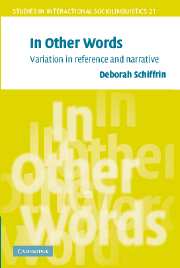Book contents
- Frontmatter
- Contents
- List of figures
- List of tables
- Preface
- 1 Variation
- 2 Problematic referrals
- 3 Anticipating referrals
- 4 Reactive and proactive prototypes
- 5 Referring sequences
- 6 Reframing experience
- 7 Retelling a story
- 8 Who did what (again)?
- 9 Redoing and replaying
- Appendix 1 Transcription conventions for data excerpts
- Appendix 2 Four versions of Susan Beer's capture story
- Appendix 3 Jack Cohen's narrative about Joey Bishop's childhood prank
- References
- Index
5 - Referring sequences
Published online by Cambridge University Press: 14 January 2010
- Frontmatter
- Contents
- List of figures
- List of tables
- Preface
- 1 Variation
- 2 Problematic referrals
- 3 Anticipating referrals
- 4 Reactive and proactive prototypes
- 5 Referring sequences
- 6 Reframing experience
- 7 Retelling a story
- 8 Who did what (again)?
- 9 Redoing and replaying
- Appendix 1 Transcription conventions for data excerpts
- Appendix 2 Four versions of Susan Beer's capture story
- Appendix 3 Jack Cohen's narrative about Joey Bishop's childhood prank
- References
- Index
Summary
Introduction
Despite the complexities involved in formulating referrals and situating referring expressions (Chapters 2, 3, 4), once speakers initiate a referral (a first-mention), their next referrals (next-mentions) continue in ways that are fairly predictable. A first-mention typically begins with an indefinite (or definite) noun phrase (e.g. a/the NP, Chapter 3) in which the work of the article and the noun complement one another: the article conveys a level of assumed familiarity and specificity of the referent; the noun provides information that helps the hearer interpret the speaker's referential intention and identify a person, place or thing in the world. The next-mention is a definite noun. The next-mention can be the NP, in which the noun repeats the first-mention or evokes the same referent through other nouns. Another alternative is the demonstrative this or that (with optional NP) that conveys proximity to, or distance from, the first-mention. But more typical than any of these forms are next-mention pronouns that provide grammatical case, number, animacy, and gender, but no lexical information.
Analyzing how referrals continue to be evoked over time situates us firmly in the internal perspective to reference (Chapter 2) and the study of word-to-world relationships within discourse. Instead of focusing on how we achieve speaker/hearer identification of a word-to-world relationship in a single referral (Chapters 2, 3), or the clauses that help achieve the familiarity so helpful to recipient identification of a referent (Chapter 4), the discourse approach in this chapter will focus on how we build a sequence of referrals within a textual world in which referents reside: how do we continuously evoke people, places and things as they acquire attributes and relate to one another over time and space?
- Type
- Chapter
- Information
- In Other WordsVariation in Reference and Narrative, pp. 154 - 198Publisher: Cambridge University PressPrint publication year: 2006



